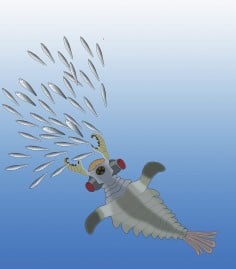Rare fossils in China show brain structures of prehistoric predators
Strange creatures' nerve structures captured for first time in fossils in China
PUBLISHED : Sunday, 20 July, 2014, 3:54am
UPDATED : Sunday, 20 July, 2014, 3:54am
Reuters in Washington

An artist's impression of a Lyrarapax unguispinus, one of the species of the world's first predators.
Researchers on Wednesday described fossilised remains unearthed in China showing in fine detail the brain structures of a bizarre group of sea creatures that were the top predators more than half a billion years ago.
The fossils show an animal called Lyrarapax unguispinus that lived during the Cambrian Period, a pivotal juncture in the history of life on Earth when many major animal groups first appeared. It was a member of a group known as anomalocaridids - primitive relatives of arthropods, which include crustaceans, insects and spiders - that hunted prey with a pair of claw-like, grasping appendages in front of the eyes.
Even though anomalocaridids do not have any direct descendants alive today, the brain structures of Lyrarapax closely resemble those of worm-like animals called velvet worms that crawl along the ground in tropical and semitropical forests in the southern hemisphere.
The researchers said the similarities suggest that velvet worms may be very distant cousins of the anomalocaridids, whose best-known example is Anomalocaris, known from a Canadian fossil site called the Burgess Shale.
Velvet worms, land animals also known as onychophorans, grow to a few centimetres in length, have two long feelers extending from the head and have numerous pairs of stubby, unjointed tubular legs that each end in a pair of small claws.
Lyrarapax, whose scientific name means spiny-clawed, lyre-shaped predator, lived 520 million years ago.
Its neuroanatomy resembles that of velvet worms in multiple ways, with a simple brain and a pair of ganglia - a cluster of nerve cells - placed in the front of the optic nerve and the base of the grasping appendages.
The soft parts of any animal's body typically decay after death, meaning that fossils usually preserve only hard parts like bones, teeth and shells. But under exceptional circumstances, soft tissue and anatomical organs can be preserved in fossils.
Lyrarapax was much smaller than some other anomalocaridids. It measured about 15cm long, roughly the size of a large shrimp. Peiyun Cong, a palaeontologist at Yunnan University, said the three specimens of Lyrarapax found "may represent immature stages of the animal, so it might be larger".
Cong added: "Anomalocaridids preserved with the whole body are very rare. None of them have been reported with the brain."
